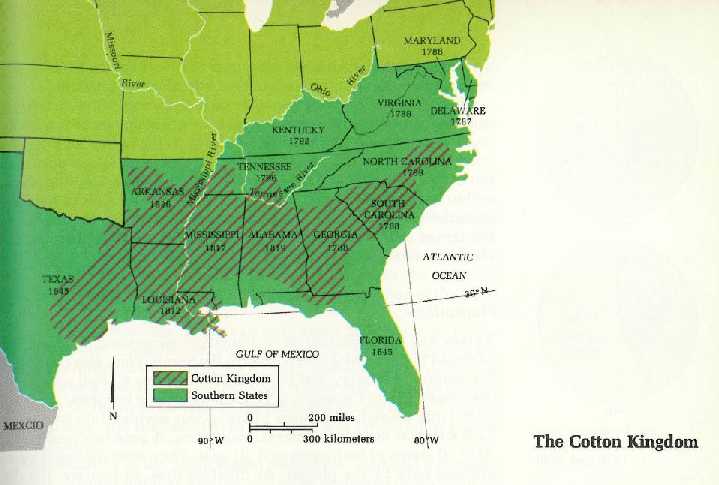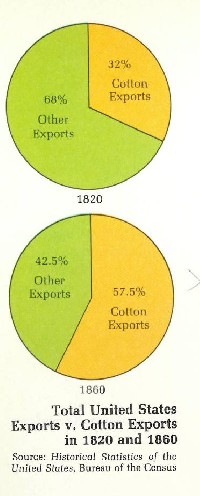|
The cotton kingdom
Looking Ahead
After the end of this section, you will be able to:
- explain the cause-and-effect relationship of the cotton gin on the southern economy;
- read a pie graph to find the percent of US cotton exported in 1820 and 1860.
The growing textile industry in the north and in Europe created great demand for raw cotton from the south. But this made a problem in itself. When cotton is picked, the boll, or ball, is filled with seeds as well as raw cotton. The seeds have to be removed, but removing them by hand is a very slow process.
In 1793, Eli Whitney designed a machine that removed the seeds from cotton. Whitney had learned of the problem while working as a tutor for the Green family of Georgia. Catherine Green, the owner of the plantation, suggested a faster way to clean cotton. Whitney’s machine was based on her suggestion. The cotton gin, as it was called, could be run either by hand, water power, or horses. With Whitney’s cotton gin, a worker could clean more than 45 kilograms of cotton in a day. As cotton farming became more profitable, it spread across the south and with it slave labor.
Cotton farming spread from the states along the Atlantic to the new states along the Mississippi. By the 1840s, the south was known as [E] the cotton kingdom.
Cotton farming needed great numbers of workers, so slavery became more profitable. From 1808 to 1860, the number of slaves in the US rose from just under one million to almost four million. Although the importing of slaves ended in 1808, a large market in buying and selling slaves within the US developed. Planters, especially in the older southern states, often broke up black families to sell members to planters in the newer states. This caused great suffering and hardship among black families.
[To improve your knowledge see [E] slave family life and [E] slave culture]


Plantations
As they had since colonial days, plantation owners and their families belonged to the highest social class in the South. They also controlled the southern economy and political life. Planters elected men to office, especially to Congress, who supported their interests.
On large plantations, cotton planting was divided into five steps. Each step was done by a different work gang. A gang was made up of 20 to 30 slaves of both sexes and all ages. They were managed by an overseer paid by the planter. At planting time, in January, the different gangs moved through the fields doing their job. First the soil was plowed. Then clumps of dirt were broken up. The ground was made level. Holed were dug, and the seeds were dropped in and cover with dirt. Planting was usually finished by late March.
When it rained or when the planting was done, male field hands cut and hauled wood, fixed fences, and repaired building and tools. Female field hands made thread, wove cloth, and sewed clothes for their families. In April, the cotton plants began to appear. The slaves looked after the fields until the cotton was ready to pick. In August, the work of harvesting began and did not end until around Christmas.
In his book Twelve Years a Slave, [E] Solomon Northrup relates his experience as a field hand on a cotton plantation. Northrup, a free black, was kidnapped in 1841 and sold as a slave to a Louisiana planter. He was rescued in 1853.
The hands are in the cotton field as soon as it is light in the morning. With the exception of ten minutes at noon, they are not permitted to be idle until it is too dark to see. They do not dare to stop, even at dinner time, until the order to halt is given.
The day’s work over, the baskets are carried to the gin-house, where the cotton in weighed. No matter how tired, a slave never approaches the gin-house with his basket of cotton but in fear. If it falls short in weight, he knows he will suffer. If it is over by ten pounds, then the owner will demand the same amount the next day. After weighing, follow the whippings. Then, the baskets are carried to the cotton house, and the contents stored away.
This done, the labor of the day is not yet ended. The slaves attend to their chores. One feeds the mules, another the pigs and another cuts the wood. At a late hour, the slaves reach their quarters. Then a fire must be built, the corn ground, and supper and also dinner for the next day prepared.
[To improve your knowledge see [E] slave labor in plantations]
Only about 50,000 Southerners were planters. However, hundreds of thousands of Southerners owned small farms. Although some of these farmers owned slaves, many did not. In North Carolina, for example, three fourths of the families owned no slaves at the time of the Civil War.
By the mid 1800s, the South had only 10 percent of the nation’s industry and was still a farming area with an economy based mainly on cotton.
Economics of Slavery
Although slavery was spreading in the mid-1800s, the system created a number of economic problems for the South. First, planters had to provide food, clothing, and shelter for their slaves. Slaves could not be fired during hard times the way free workers could. Because planters invested much of their money in land and slaves, they could not afford to invest in new labor-saving machine, such as mechanical cotton pickers. As a result, planters could not decrease their use of slaves. Slavery became a cycle that seemed to have no end. Yet, while it was costly, slave-run plantations often produced large profits for their owners.
Looking Back
- How did the cotton gin affect the slavery in the South?
- Why did the South remain mainly a farming region?
- Use the pie graph to answer the following: a. What percentage of total US exports was cotton in: 1820? b. 1860? c. From this graph, what could you say about cotton's importance to the US economy before the Civil War?
 6/16
6/16

|